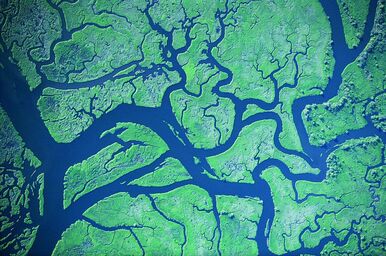CONSERVATION CORNER
A weekly blog for all things conservation
 By: Joe Quatrini, Technical Team Leader, BCCD Last week you read about watersheds and hopefully that got you thinking about how our actions locally impact streams and other waterbodies nearby and even regionally. Today, we’ll narrow our focus a bit to discuss stream order. Simply put, stream order categorizes streams by their size. There’s a little more to it than that, however, its relatively uncomplicated. There’s a basic numbering system: First Order, Second Order, Third Order, and so on, that describes a stream and its position relative to other streams in a watershed. A first order stream is a ‘headwater’ stream or a stream that originates from a spring, a wetland, or a pond, etc. You may have a wet spot in a field on your property and as that spot drains downhill it starts to concentrate, picks up speed, and creates a channel with a defined bed and banks. This would be a first order stream. Sometimes what might complicate this is if someone digs a ditch across their property and after some time, it appears to be a stream and may be categorized as such. This is where some landowners may encounter issues with state or federal agencies if they try to alter or maintain that ‘ditch’ once stream characteristics start to develop. If you’ve been following this column over the last couple years, you’ve read over and over that usually the best option when dealing with water is to let it spread out and not to concentrate it. This adds another dimension to that argument where your initial solution to a problem has created a new problem for you now. Anyway, back to stream order. Stream order only changes downstream of the confluence (spot where two steams meet) of two streams of the same order. That is, if a first order stream enters a second order stream, that stream remains second order downstream of their confluence. So, downstream of the confluence of first order stream A and first order stream B would be a second order stream. This location could have a similar name to one of the streams that flow into it, or it could have a new name altogether (we’ll discuss stream names in a future article). Similarly, downstream from the confluence of two second order streams would start a third order stream, etc., etc.
So what? They’re all streams, right? Well, yes, but often those first and second order headwater streams are different ecologically and are critically important to the health of the watershed and the organisms that inhabit them. Many species of fish, macroinvertebrates (yep, we’ll cover them later as well), reptiles, and amphibians need cool, clear, headwater streams to successfully reproduce and complete their life cycles. We also need cool, clean source water to supply fresh water for people and animals. The cleaner the water is where it starts, the less we have to treat it for consumption, saving money and resources. Approximately 70% of all waters in the US are first or second order streams. Often, because of their small size, these are the streams that are considered inconsequential. Many face significant human impacts (alteration, pollution) which is unfortunate because they may be the most important. If you live near or own property containing a first or second order headwater stream, there are some simple things you can do to protect them. First, try not to dig in them, straighten them, run them through pipes, or allow any type of pollutant in them or near their banks. The stream will respond to any of these activities, and most likely in a negative way. Second, limit the amount of roof runoff, tile drains, and other sources of concentrated flow you direct to them. Based on its position in the landscape, it only has the capacity to handle a certain flow at a specific rate and altering that can have negative consequences. Third, leave natural vegetation along it. This may be grass, shrubs, trees, or a combination of all the above. The vegetation will hold the soil in place and reduce erosion while providing nutrients and insects to support aquatic life. The tree canopy will also provide shade and cool the water. The Bradford County Conservation District is committed to helping people manage resources wisely. You can visit the Bradford County Conservation District at 200 Lake Rd in Wysox across from the Wysox Fire Hall. Contact us at (570) 485-3144 or visit our web page at www.bccdpa.com.
1 Comment
|
AuthorsVarious staff at the Bradford County Conservation District Archives
April 2024
Categories
All
|
